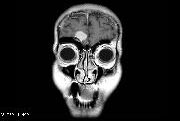What if you have a headache that feels bad while standing but goes away after lying down?
This is often caused by intracranial hypotension. A certain pressure level is maintained
around the brain. When there is a hole or tear in the dura, the envelope that surrounds the
brain and the spinal cord, the fluid that bathes the brain (CSF) may slowly leak out, resulting
in reduced pressure and positional headaches. Sometimes the hole results from trauma, but
many cases appear to occur spontaneously.
There are several tests that may help make this diagnosis, but they are prone to errors and
they are not perfect. When an MRI of the brain is done for a patient with this symptom,
there may be a sign of settling of the inferior brain on the skull base. A spinal tap may show
that the CSF pressure is reduced. A special study called a nuclear cisternogram can be
done. In this study, a radiotracer is placed into the CSF by a spinal tap procedure. The study
helps show if the radiotracer compound diffuses throughout the CSF space, leaks out of a
certain location, or at least disappears due to leaking much faster than to decay of the signal.
Many patients with this disorder recover spontaneously, but some do not. Medications may
help the symptoms, but they are often not helpful. A blood patch procedure is often a cure
for this. This is done by taking whole blood from a patient’s vein. This is prepared and then
injected to the epidural space. The blood products have a tendency to locate a site of
injured tissue and form a small blood clot to cover it. Often this works as a band aid for a
leaking meningeal lesion, and if it is small enough, this can help to close the lesion.
Sometimes more than one blood patch is needed. When the blood patch does not help,
sometimes surgery is needed to close the tear.
The positional headache is something that occurs spontaneously, but sometimes it occurs
after medical procedures. Patients who are subjected to spinal tap or epidural anesthesia may have symptoms of what is called a spinal headache. This is identical
to the headache of spontaneous intracranial hypotension described above. Although many
patients who have a nosocomial (procedure related) headache improve in a few days, some
of them do not. In these cases, the blood patch is routinely performed.
Treatment
Although a CSF leak may occur anywhere, the most common site is within the thoracic
spine. A blood patch is an effective therapy even if it is not administered near the site of the
CSF leak. The blood cells and proteins in the blood patch are capable of locating a site of
injury and repairing it. A blood patch administered to the lumbar spine is the best-tolerated
approach.
There are rare refractory cases that do not respond to the blood patch. Surgery can be
helpful for repairing CSF leaks, especially those that occur following trauma. In such a case,
localization of the CSF leak is necessary. Intravenous antibiotics may also be needed to
prevent infections from crossing an injured dura.
